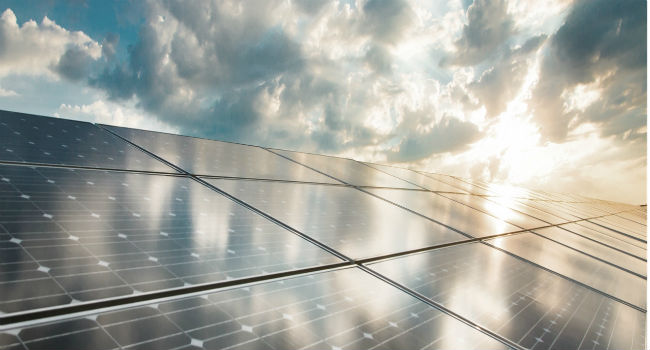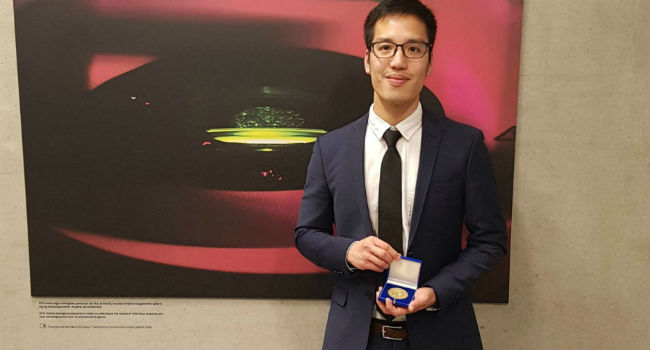As we are moving into an era where humanity becomes more and more dependent on solar- and wind power, we need systems that harvest this energy to operate flawlessly all the time. Therefore it is of great importance to be able to predict the lifetime of the power electronic components so that you can prevent break downs. This specific challenge has been the focal point of AAU-scientist Ariya Sangwongwanich’s PhD-thesis, for which he has just recently received the Ph.D.-prize of The Danish Academy of Natural Sciences.
- It is a great honor for me to receive this prize. This recognition is not only to my work but also indicates that people are giving more and more attention to solar energy technology here in Denmark. I’m really happy to be a small part that push this technology further and help society become more sustainable, says Ariya Sangwongwanich, who is Postdoc at the Department of Energy Technology at Aalborg University.
Ariya Sangwongwanich’s work is focused specifically on predicting when power electronics will fail. This is necessary to integrate solar power effectively into the electrical network.
- My work is to design solutions and components that will make the integration of solar power into the overall electrical network seamless, as well as predict how long the different components will last before they fail, says Ariya Sangwongwanich.
More than 100 parts of power electronics can fail
The integration of solar power into the electrical network requires power electronics. Power electronics simply convert the electricity that is generated by e.g. a solar panel and turn it into the kind of electricity that flows into people’s homes. This also means that if the power electronics stop working, the espresso machine in your home won’t work. Unfortunately, power electronics have a tendency to break down.
An electricity converter for solar panels has more than 100 components that can wear down and fail at any point in time. Therefore owners of solar power plants would like to know, which parts that will break down and at what time they will do it. Ariya Sangwongwanich can tell them that.
- It is all about the reliability of the system. If you know what parts that will fail and you can estimate at what time, you minimize the downtime of the system and can also save on expensive spare parts, Ariya Sangwongwanich explains.
Combines statistics with modelling
To be more specific, Ariya Sangwongwanich has developed a mathematical approach that makes him a soothsayer of power electronics.
Firstly, he statistically explores, which parts of a power electronics system that is most prone to fail. This might be a switch or a capacitor.
When the top 10 candidates are defined, he moves on to modelling the risk of failure for each part under the given circumstances. In the modelling he includes variables like exposure to sun and heat and combine this with the strength of the material in question.
- Some parts might have a long lifespan in Denmark where there is not that much sun in the winter, but the same part might be prone to breaking down fast in Saudi Arabia where it is operating on full capacity and in high temperatures most of the year. This influences the longevity of the component, Ariya Sangwongwanich says.
When finally, Ariya Sangwongwanich have an estimate of the risk of failure for each part, he applies statistical margins of error to his calculations to come up with a prediction of when the power electronics component needs servicing.
Interest from all sides
This approach to calculate the lifetime of power electronics has already gained interest from different sides.
Manufacturers of power electronics can use the insight to specify warranty on their products.
Constructors of solar power plants can use the information to make a cost benefit analysis. Some components might be cheaper, but if they break down too fast it will probably be more feasible to go for pricier but more durable power electronics components to start with.
In maintaining a solar power system, the knowledge can also be used to know which parts to keep an eye on.
- Many people from both academia and the industry can use this approach. We are one of the first to establish this methodology, but more are looking into it, and we are so far getting good feedback, Ariya Sangwongwanich says.
On November 29th Ariya Sangwongwanich from the Department of Energy Technology at Aalborg University received the Ph.D.-prize of The Danish Academy of Natural Sciences for his Ph.D.-thesis titled “Grid-Friendly High-Reliability Photovoltaic Systems”.
Contact
- Ariya Sangwongwanich, Postdoc at Department of Energy Technology at Aalborg University, +45 3185 1067, ars@et.aau.dk
- Sanne Holm Nielsen, press contact, tlf. 9940 3517, shn@adm.aau.dk


